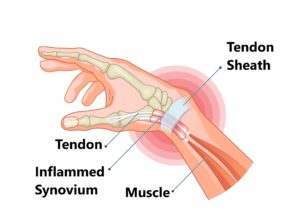 You are probably reading this article because you have that uncomfortable, disabling, annoying pain in your thumb on the outside of your wrist. You came to the right place. We are going to explain how you can know if what you are suffering from is Quervain’s tendonitis.
You are probably reading this article because you have that uncomfortable, disabling, annoying pain in your thumb on the outside of your wrist. You came to the right place. We are going to explain how you can know if what you are suffering from is Quervain’s tendonitis.
The best way to find out is to see a doctor or physical therapist. However, you can start to have your suspicions already when deciding to visit a professional.
What is de Quervain’s tendonitis?
It is an inflammation of the extensor tendons, including the adductor pollicis longus, all those that are located on the outside of the wrist and outside of the thumb are the muscles that allow the finger to be opened and extended, and even to do the radial tilt. They are the muscles that make up the anatomical snuff box.
How does de Quervain’s tendonitis occur?
It is not known or it is not very clear, it could be said that they are extensor muscles, they are separator muscles and they have some much more powerful flexor muscles – those to grasp, to close, etc. – therefore, a work activity that works a lot in finger presses, pincers, pronation, which makes those muscles always stretched it could be a theory as to why it happens and sometimes sure this is participating.
But there has to be more than this, which has an origin more in the cervical area, a descending origin, and influencing these tendons.
It is also known that it is much more frequent tendonitis in women who have given birth, who are holding their babies for a long time. These factors play an important role.
Typical signs and symptoms of Quervain’s Tenosynovitis
We are going to see a series of symptoms and key signals. You will learn about a test that is very enlightening when it comes to knowing if you have Quervain’s tendonitis.
- Pain in the external area of the wrist and thumb on movement and touch. If you squeeze in that area, it will be sore.
- Pain on ulnar tilt to the wrist with the finger held. That is, when a tightness appears, a fairly intense and unpleasant pain.
- Inflammation and swelling in the area, sometimes much more pronounced because not only is it inflamed, or not only an inflammation of the tendon but the tendon sheath is inflamed. It is a wrap that surrounds the entire tendon and provides it with a sliding surface. This sheath is the one that tends to become inflamed, which is why it is called tenosynovitis “inflammation of the tendon and the synovial sheath” producing important and very liquid inflammations.
- Tendon protrusions are like internal crunches because they can be felt to the touch as a result of the sliding of this tendon with the sheath, also known as crackles.
Summing up
Quervain’s Tenosynovitis is a disease that afflicts people daily, whether due to bad movements in the workplace, practicing sports, or simply doing chores around the house. If you experience any of the above symptoms, consult a professional for help.
Tendonitis is usually very painful and even becomes chronic if it is not treated in time. A physical therapist will make a diagnosis and help you with proper kinesiological rehabilitation. Check out one-on-one physical therapy and its benefits can help cure your tendonitis. Don’t neglect your health!


